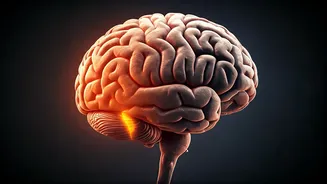Speech as a Mirror
The examination of natural speech provides a unique window into cognitive function. It has been found that subtle changes in speech patterns can be indicative
of underlying cognitive issues, such as difficulties with memory, language processing, or executive function. These shifts might not be immediately obvious in everyday conversation, but meticulous analysis can uncover them. Speech analysis employs various techniques, including the assessment of speech rate, pauses, and the complexity of sentence structures. Moreover, researchers examine the frequency of specific words or phrases, which may reflect cognitive limitations. By studying speech characteristics, scientists can identify early warning signs of cognitive decline, potentially leading to timely intervention strategies. This approach is especially promising because speech is a readily accessible and non-invasive marker of brain health, making it an advantageous method for broad screening and ongoing monitoring.
Analyzing Speech Patterns
Speech analysis involves employing a variety of methods. Researchers might record the speech of individuals while they are engaged in tasks. They could also have them describe a picture, tell a story, or simply converse freely. The recorded speech is then processed using computer algorithms to extract quantifiable features. For instance, the rate at which words are spoken can be measured. Pauses and hesitations are noted, and the diversity of vocabulary used is assessed. Furthermore, the accuracy and coherence of the produced language are evaluated. These metrics are then compared to established norms or to baseline data collected from the same individual at an earlier time. Deviations from these norms can signal cognitive decline. Sophisticated algorithms are used to identify complex patterns that may not be apparent to the human ear. Machine learning models have further revolutionized this field by identifying combinations of speech characteristics which offer the greatest predictive power for assessing cognitive status.
Early Detection Benefits
The ability to detect cognitive decline early holds considerable promise for improving patient outcomes. When cognitive issues are identified early, individuals can have the opportunity to implement lifestyle changes and therapeutic interventions that may slow down the progression of the disease. These interventions include cognitive training exercises, medication, and lifestyle adjustments such as diet and exercise. Early diagnosis also allows individuals and their families to plan for the future, making informed decisions about care and financial planning. Speech analysis can serve as a vital screening tool to pinpoint at-risk individuals early. This method provides the advantage of being non-invasive and easy to implement in various settings, including clinics and even remotely via telehealth platforms. As the technology continues to advance, speech analysis may play an increasingly crucial role in enabling proactive and personalized strategies for maintaining cognitive health.
Future Research Directions
Future research in speech analysis for cognitive decline will probably focus on several key areas. Firstly, investigators are refining the algorithms and statistical models that are used to analyze speech data. The goal is to improve the accuracy and sensitivity of these tools. Furthermore, scientists are exploring the use of speech analysis in combination with other diagnostic methods, such as neuroimaging and neuropsychological testing, to provide more comprehensive assessments. Researchers are looking into developing personalized speech models, which will consider individual differences in speech patterns based on age, education, and language background. Moreover, they are looking to expand the research to diverse populations to ensure the validity and reliability of the techniques across different demographics. Eventually, the goal of research will be to translate these findings into practical and cost-effective screening tools that can be used by healthcare providers worldwide.















